
Do you have a question about the Alpine IVA-W502R and is the answer not in the manual?
| Brand | Alpine |
|---|---|
| Model | IVA-W502R |
| Category | Car Receiver |
| Language | English |
Keep small objects away from children to prevent accidental swallowing and serious injury. Seek medical attention if swallowed.
Use the correct fuse rating to prevent fire or electric shock. Ensure correct replacement to avoid hazards.
Ensure vents are clear to prevent heat buildup and potential fire. Proper airflow is crucial for safe operation.
Use the product only for its intended 12V mobile application to prevent fire, electric shock, or injury.
Avoid inserting foreign objects into slots or gaps to prevent personal injury or product damage.
Important instructions for preventing injury or property damage. Heed all warnings and cautions for safe operation.
Stop using the product immediately if a problem arises to prevent injury or damage. Contact dealer for repair.
Keep fingers clear of moving parts to prevent injury or product damage. Be cautious of monitor movement.
Use a soft, dry cloth for cleaning. Dampen with water only for severe stains to avoid damaging paint or plastic.
Ensure vehicle temperature is between 0°C and +45°C before operating the unit to prevent damage.
Remove disc and wait for moisture to evaporate if playback wavers due to condensation. Allow unit to dry.
Do not play cracked or warped discs to prevent damage to the playback mechanism. Use only undamaged discs.
Do not attempt self-repair. Return the unit to an authorized Alpine dealer or service station for servicing.
Do not pull discs during auto-reload or insert discs when the unit is off. Avoid these actions to prevent unit damage.
Insert one disc at a time with the label side facing up. Use RESET switch if "DISC ERROR" persists. Bumpy roads may cause skips but not damage.
Use only round discs. Special shaped discs may cause mechanism damage. Avoid non-standard disc formats.
Check new discs for bumps around the center hole and edge. Rub to remove bumps to ensure proper loading.
Avoid installing in locations with direct sun, high humidity, water, dust, or excessive vibrations. Ensure proper installation.
Do not drop discs, leave fingerprints, or affix labels/stickers/gummed labels. Do not write on discs.
Wipe discs with a clean, soft cloth. Use mild detergent solution for heavily soiled discs to ensure proper playback.
Lists disc types supported by the unit, including DVD Video, DVD Audio, Video CD, Music CD, and DivX®, with format details.
Shows compatibility for CD-R/CD-RW, DVD-R/DVD-RW, DVD+R/DVD+RW for various formats.
Provides guidance on creating audio CDs and MP3/WMA/AAC CDs for optimal playback. Explains file formats and compatibility.
Explains that Audio CDs are commercial format, while MP3/WMA/AAC use compression for smaller file sizes.
Unit can read both CD-DA and MP3/WMA/AAC sections on hybrid discs. Choose CD-DA for audio or MP3/WMA/AAC for data.
Unit reads multisession DATA formatted discs (MP3/WMA/AAC), but not Audio CD files. Data can be added to unfinished sessions.
Use ISO9660 formatting for proper playback. Supports Level 1, Level 2, and Joliet file naming conventions.
Handling precautions include not touching the surface, avoiding sunlight, not affixing labels, cleaning discs, and ensuring flatness.
Supports standard DVD-Video and DVD-VR formats. Unfinalized discs and discs with copy protection may not play.
Use only specified cables and avoid USB hubs. Connect only iPod, USB memory, or portable players. Back up important data.
Unit controls USB Mass Storage Class devices. Avoid extreme temperatures, humidity, or corrosive substances. Fix USB memory securely.
Supports portable players via USB interface. Avoid extreme conditions and ensure proper fixing. Check compatibility settings.
Legal notice regarding copyright protection technology and licensing. Reverse engineering is prohibited.
Lists all included accessories such as head unit, cables, screws, and owner's manual. Check all items are present.
Identifies key control buttons and their functions on the unit's face and touch screen. Explains button descriptions.
Explains how to turn the unit on using the SOURCE button and how to turn it off by pressing and holding it. Emphasizes stopping the vehicle first.
Detailed steps for inserting and ejecting discs for both IVA-W505R and IVA-W502R models. Includes cautions for safe operation.
Instructions for adjusting the monitor's tilt angle for optimal viewing. Explains the 5-stage adjustment process.
How to adjust volume using the unit's buttons or optional remote control. Volume range is 0-35.
Guidelines for operating touch-screen buttons gently to protect the display. Recommends retrying if a button press is unresponsive.
Step-by-step guide to switching between different audio/video sources like Radio, Disc, or USB Audio. Explains display examples.
How to access and use the numeric keypad for inputting titles, chapters, or country codes. Shows keypad layout and operation.
Instructions on how to change the display style (e.g., Style 1, Style 2) for different sources like iPod or Disc. Explains customization options.
Guide to manually storing desired radio stations into preset memory slots (P.SET 1-6) for quick access.
How to automatically scan and store up to 6 strong stations on a selected band using the A.MEMO function. Explains the process.
Steps to recall stored radio stations by selecting the desired band and pressing the preset buttons (P.SET 1-6).
How to enable/disable the AF function for automatic re-tuning to stronger signal stations broadcasting the same programme.
How to activate the Traffic Announcement (TA) mode to receive traffic information and how the unit behaves during broadcasts.
Guide to searching for radio stations based on Programme Type (PTY). Explains how to select PTY and initiate a search.
Explains how traffic information interrupts CD/Radio playback and automatically resumes the original source afterwards.
Function to prioritize News programs, interrupting current listening. Activates the NEWS indicator and can be deactivated.
How to display text messages broadcast by radio stations. Shows "WAIT" and "NO TEXT" indicators.
Basic playback controls for discs, including track selection, fast forward/backward, and pause. Includes notes on file types and playback time display.
How to set repeat modes (Track, Title, Disc, OFF) for various disc types. Explains settings for CD and MP3/WMA/AAC.
Instructions for enabling random playback of tracks or albums for CD and MP3/WMA/AAC. Explains cancellation and folder-specific shuffle.
How to navigate and select folders when playing MP3/WMA/AAC files on a disc. Allows browsing through directory structure.
Warning against unauthorized duplication or distribution of audio data due to copyright laws.
Explanation of MP3 compression technology, its benefits in reducing file size while maintaining near CD quality.
Explanation of AAC (Advanced Audio Coding) as an audio compression format used by MPEG2 or MPEG4.
Explanation of WMA (Windows Media Audio) as compressed audio data offering CD quality sound with small file sizes.
Guidance on creating MP3/WMA/AAC files using software codecs, specifying file extensions and supported versions.
Lists supported sampling rates and bit rates for MP3, WMA, and AAC files for optimal playback compatibility.
How the unit displays tag data like title, artist, and album name. Mentions character limitations and "NO SUPPORT" display.
Describes how MP3/WMA/AAC files are written to discs and supported file systems. Mentions limitations on files/folders and playback time.
Defines terms like Bit rate, Sampling rate, Encoding, Tag, and Root folder, essential for understanding disc formats.
Explains the icons used to denote DVD-V, DVD-A, DVD-VR, VCD, and DivX® disc compatibility.
Critical warning about the dangers of watching video while driving, emphasizing potential accidents and injuries. Correct installation is vital.
Steps to access the DVD mode screen for playing discs. Includes a caution about using auxiliary devices while driving.
General cautions regarding DVD playback, including function limitations, fingerprint issues, and power/source changes.
Explains how playback resumes from the stopped point after power off or source change. Ensures continuity of viewing.
How to navigate DVD menus using KEY, RETURN, and ENTER buttons. Allows selection of menu items for playback control.
Detailed steps for using the numeric keypad for VCD input or entering parental lock codes. Explains keypad layout and confirmation.
How to access the DVD's top menu screen when multiple titles are present. Guides users to necessary operations.
How to access the DVD menu screen when multiple menus are available. Guides users to necessary operations.
How to access the DVD menu operation mode screen using the function guide and MENU CONT. Explains DVD-Audio playback settings.
How to search and play programmes from a list on DVD-VR discs. Ensures correct program selection.
How to search and play playlists from a list on DVD-VR discs. Requires discs containing playlists.
How to temporarily stop playback and resume from the stopped position. Position is stored in memory.
How to fully stop playback of discs. Explains resuming playback from the beginning when stopped.
How to fast-forward or reverse playback on various disc types. Explains speed variations and operation details.
How to quickly navigate to the start of chapters, tracks, or files on discs. Explains button usage and requirements.
How to pause playback to view a still frame. Explains resuming playback and potential temporary image/sound stops.
How to advance or reverse playback frame-by-frame in pause mode. Notes on sound output and disc type compatibility.
How to play back in slow motion by holding buttons in pause mode. Explains speed variations and sound output.
How to skip to the next programme on a DVD-VR disc using the function guide. Requires specific button presses.
How to skip to the next playlist on a DVD-VR disc using the function guide. Requires specific button presses.
How to navigate and select folders when playing DivX® discs. Allows browsing through directory structure.
How to set repeat modes (Track, Title, Disc, OFF) for various disc types. Explains settings for DVD Video and Video CD.
Instructions for repeat playback modes (VCAP, VOFF) for DVD-Audio discs. Includes track, group, and disc repeat options.
Instructions for repeat playback modes for DivX® files. Includes file, folder, and disc repeat options.
How to use the numeric keypad to search for specific titles, groups, programmes, or playlists on DVDs. Guides users to the correct input.
How to use the numeric keypad to quickly find chapters, tracks, or files on discs. Explains function guide usage.
How to switch between multiple camera angles recorded on a DVD during playback. Explains seamless and non-seamless angle changes.
How to navigate pages of still images on DVD-Audio discs. Includes touching and holding for home page access.
How to switch between different audio languages or multiplex audio tracks during playback. Explains default settings.
How to switch subtitle languages or hide subtitles on DVDs. Explains default settings and ON/OFF function.
How to switch audio language, angle, and subtitles directly from the disc's menu. Requires accessing the menu first.
How to display disc status information like title number or chapter number during playback. Explains touch panel operations.
Introduction to DivX® as a video compression codec. Lists features like official certification and supported file extensions.
Introduces various advanced features of the unit. Points to specific sections for details on audio adjustment and other functions.
Guide to accessing the Audio Setup screen for adjusting bass, treble, balance, fader, and other sound settings. Explains display examples.
Step-by-step guide to adjust front/rear balance and left/right fader for optimal sound distribution. Explains fine-tuning controls.
How to turn Defeat mode ON or OFF. Disables MX effect and resets EQ to initial settings when Defeat is ON.
How to adjust the volume level for navigation system voice prompts. Requires NAV. MIX to be ON and compatible processor.
How to turn the subwoofer ON/OFF and adjust its output level. Explains ON/OFF setting and level adjustment range.
How to adjust the highpass filter for speakers. Explains setting OFF, frequency ranges, and speaker selection compatibility.
How to adjust bass and treble frequencies to customize tonal preference. Covers bass/treble level, center frequency, and bandwidth.
How to adjust the center frequency for bass emphasis. Explains setting range and individual memorization per source.
How to adjust the bandwidth of boosted bass frequencies for wider or narrower emphasis. Explains WIDE1 to WIDE4 settings.
How to adjust the treble level for emphasis. Explains setting range and individual memorization per source.
How to adjust the center frequency for treble emphasis. Explains setting range and individual memorization per source.
How to turn Loudness ON or OFF to compensate for decreased sensitivity at low listening levels. Enhances bass and treble.
How to search for desired tracks or folders in CD, MP3/WMA/AAC, or DivX® modes. Explains search list and hierarchy.
Introduction to DVD setup operations. Notes that parking brake must be engaged for access.
General steps for DVD setup operations. Mentions common operations and the need for parking brake engagement.
How to set menu, audio, and subtitle languages. Explains AUTO selection and default factory settings.
How to set the language for menus, including title menus. Lists supported languages and AUTO option.
How to set the audio language produced from speakers. Lists supported languages and AUTO option for primary language.
How to set the language for subtitles displayed on the screen. Lists supported languages and AUTO option.
How to set the country code for rating level (parental lock). Explains AUTO/OTHER options and language number input.
How to set parental lock levels to restrict viewing by age. Covers setting input, password, and temporary level changes.
Steps to change the parental lock password using the numeric keypad. Emphasizes keeping the password safe.
How to temporarily change the rating level when prompted by a disc. Explains YES/NO options and password input.
How to set the digital audio signal output mode (AUTO or LPCM) for Dolby Digital and other audio signals.
Table detailing audio recording formats, digital output settings, optical digital output, and analog output for various disc types.
How to set downmix modes (SURROUND/STEREO) for Dolby Digital and DTS sound. Explains 16:9 WIDE setting for widescreen TVs.
How to adjust the output screen mode (4:3 LB, 4:3 PS, 16:9) based on the connected TV monitor. Describes LETTER BOX and PAN-SCAN options.
How to memorize a 4-digit code for bonus groups on DVD-Audio discs. Requires code from disc jacket.
How to select DVD-Audio playback settings (VIDEO, VCAP, VOFF) for discs containing both video and audio.
How to set file play mode (CD or CMPM) for discs with mixed audio and data. Explains usage with CD changers.
How to choose playback for compressed video or audio files on discs containing both. Options are AUDIO or VIDEO.
How to view DivX® file information, including registered codes, by touching DivX INFO.
How to enable or disable Playback Control (PBC) for Video CDs. Explains PBC menu display options.
Introduction to Radio setup operations. Notes parking brake requirement and common steps.
General steps for radio setup, including accessing settings like RDS clock, FM level, PI SEEK, and PTY language. Mentions parking brake requirement.
How to set the clock to automatically adjust using RDS time data or manually. Explains OFF/ON settings.
How to adjust FM signal level (LOW/HIGH) to balance volume differences between CD and FM radio.
How to set PI SEEK to OFF or AUTO for receiving related local RDS stations. Controls regional station reception.
How to keep receiving local RDS stations when OFF is selected, or switch to regional stations when ON is selected.
How to select the display language pattern for PTY (Programme Type) information. Lists supported language codes.
How to enable or disable PTY31 (Emergency Broadcast) reception. Explains priority for alarms and "ALARM" display.
Introduction to display setup operations. Notes parking brake requirement and common steps.
General steps for display setup, including adjusting brightness, background, and screen alignment. Mentions parking brake requirement.
How to adjust monitor backlighting brightness (OFF/ON/AUTO) based on ambient car lighting for easier viewing.
How to adjust the minimum backlight brightness level (LOW) for night travel. Explains adjustment range and display indicators.
How to select background textures from MODE1, MODE2, MODE3. Notes limitations for external sources and error messages.
How to enable automatic background texture changes each time the ignition key is turned ON/OFF. Explains scrolling behavior.
How to select font back display colors (BLUE, RED, GREEN, AMBER) for source titles and shortcuts.
How to align the touch panel if the display and touch positions do not match. Includes calibration and reset procedures.
General steps for accessing and operating General Setup menu items. Notes parking brake requirement and common operations.
How to turn the clock display ON or OFF. Explains the impact on manual adjustment.
How to adjust the clock's hour, minute, and reset time. Explains time adjustment cancellation and RDS Time Display interaction.
How to enable or disable Daylight Saving Time. ON advances the time by one hour for summer time.
How to turn the demonstration function ON or OFF to show basic operations. Repeats automatically until turned off.
How to enable or disable the sound guide beep for button presses. ON activates the sound guide mode.
How to set AUTO SCROLL for text display when information is entered. ON enables continuous scrolling.
How to select font types, including Russian and European fonts. Notes limitations for certain modes.
How to adjust the brightness of button lighting at night using the dimmer. Explains setting level range.
General steps for accessing and operating System Setup menu items. Notes parking brake requirement and common operations.
How to enable/disable external device interruption (e.g., navigation voice) for audio sources. Requires Ai-NET Interrupt Box.
How to display icons (INT or TEL) for external devices like telephones when an interrupt signal occurs.
How to switch the remote sensor between the unit's FRONT sensor or the external monitor's REAR sensor.
How to enable rear camera input for video output to the monitor. Supports NTSC/PAL and reverse trigger.
How to enable/disable the navigation source display and control. Requires optional navigation equipment.
How to mix navigation voice guidance with audio sources. Explains NAV. MIX function and volume adjustment.
How to enable/disable AUX source display and input selection. Supports various input types like GAME, TV, DVB-T.
How to adjust the audio level for external inputs (AUX) to LOW or HIGH. Requires AUX Mode to be ON.
How to change the video input signal system between NTSC and PAL. Requires AUX Mode to be ON.
How to output the selected source picture to the rear monitor. Explains OFF/ON settings and RSE selection.
How to set up Bluetooth connection (OFF, NAV., ADAPTER). Explains TEL screen display and Voice Dial function compatibility.
How to enable/disable the USB Adapter source display. Affects source name visibility on the selection screen.
How to assign functions (VISUAL or NAV.) to the VISUAL soft button for quick recall.
How to change the function of the OPTION button to V. SEL or TEL for quick access to settings.
How to set the digital output to ON for connecting an audio processor via optical digital output. Requires ACC cycle.
How to enable/disable AUX+ source display for iPod or portable music players. Requires iPod Direct connector.
How to adjust the audio level for AUX+ input to LOW or HIGH. Requires AUX+ Mode to be ON.
General steps for L.L.C. setup, including accessing the screen and adjusting settings. Notes parking brake requirement.
How to adjust picture darkness (brighter/deeper black) using the L.L.C. function. Explains effectiveness levels from 1 to 5.
How to select visual EQ modes (FLAT, NIGHT M., SOFT, SHARP, CONTRAST, P-1, P-2) for subject image optimization. Includes custom settings.
How to adjust the screen brightness level from -15 to +15. Explains MIN/MAX display and interaction with AUTO dimmer.
How to adjust picture colour saturation from -15 to +15. Explains MIN/MAX display and mode limitations.
How to adjust picture tint (colour tone) from G15 to R15. Explains display indicators and mode limitations.
How to adjust image contrast from -15 to +15. Explains LOW/HIGH display and minimum/maximum values.
How to adjust picture sharpness from -15 to +15 (SOFT/HARD). Explains mode limitations and compatibility with RGB features.
How to store custom visual EQ settings (brightness, tint, etc.) into user memory presets (P-1, P-2) for recall.
Introduction to downloading data, such as wallpapers, from Alpine's website. Guides users to the download process.
Step-by-step guide to download background data from Alpine's website to a CD-R/RW and then to the unit. Explains file selection and overwriting.
Information about connecting and operating external audio processors like PXA-H700/PXA-H701. Notes specific feature limitations and compatibility.
Step-by-step guide for adjusting settings to achieve accurate Dolby Digital and DTS surround sound. Covers speaker setup, levels, and acoustic image.
How to access and adjust processor settings like Media Xpander, Bass Sound Control, and Pro Logic II. Notes Defeat mode and specific processor compatibility.
How to adjust bass sound levels using Bass Compressor and Bass Focus settings. Explains mode selection and time correction.
How to set time difference between speakers for time correction, enabling audible time correction. Explains front/rear and left/right adjustment.
How to enable Dolby Pro Logic II surround sound for 2-channel sources. Explains PL II MOVIE and PL II MUSIC modes.
How to turn Media Xpander (MX) effect ON or OFF and select specific MX modes for various sources (CD, CMPM, FM, DVD, AUX). Enhances vocals and instruments.
Explains MX modes for CD sources, using data quantity to reproduce clean sound. Lists OFF and CD MX 1-3 settings.
Explains MX modes for CMPM sources, correcting compression omissions for balanced sound. Lists OFF and CMPM MX 1-3 settings.
Explains MX modes for FM sources, enhancing medium to high frequencies for balanced sound. Lists OFF and FM MX 1-3 settings.
Explains MX modes for DVD sources, enhancing dialog clarity. Lists OFF and MOVIE MX 1-2 settings.
How to choose MX modes (CMPM, MUSIC, MOVIE) corresponding to connected media. Explains OFF setting and source-specific MX.
How to adjust equalizer settings using 31 bands for front/rear/center and 10 for subwoofer. Allows sound customization.
How to change the unit of time correction between centimeters (cm) and inches (Inch). Selects the unit for distance measurement.
How to measure distances and calculate time correction values for speakers to equalize sound arrival. Explains calculation and setting process.
How to switch speaker phase (0° or 180°) for optimal sound. Selects the desired speaker phase.
How to use the graphic equalizer to modify sound with 31 bands. Explains adjustments for speakers and subwoofer.
How to fine-tune equalizer settings by adjusting center frequency, bandwidth (Q), and level for specific frequencies. Advanced audio tool.
How to adjust the frequency for selected bands in the parametric equalizer. Lists adjustable frequency bands and steps.
How to adjust the level for selected bands in the parametric equalizer. Explains adjustable output level range.
How to adjust the bandwidth (Q) for selected bands in the parametric equalizer. Explains adjustable bandwidth options.
How to adjust G-EQ for preference by selecting bands, levels, and repeating for all bands. Notes graphic EQ interaction with parametric EQ.
How to adjust crossover settings (HPF/LPF) for speakers. Explains L+R/L/R selection and speaker list access.
Details crossover settings for 4.2ch systems, including cut-off frequency, slope, and level. Covers front, rear, and subwoofer configurations.
Details crossover settings for 2.2ch 3WAY systems, including cut-off frequency, slope, and level. Covers low, mid, and high range speakers.
How to select the cut-off frequency (crossover point) for speaker bands in 4.2ch and 2.2ch systems. Explains adjustable bandwidth differences.
How to adjust the HPF or LPF level for speaker bands in 4.2ch and 2.2ch systems. Explains the adjustable output level range.
How to adjust the HPF or LPF slope for speaker bands in 4.2ch and 2.2ch systems. Lists adjustable slope values and notes conditions.
How to store X-OVER, T.CORR, and P/G-EQ settings into memory presets (P.SET 1-6). Notes that stored contents vary by processor.
How to recall stored settings from memory presets (P.SET 1-6) on the A.PROCESSOR list. Takes time to load.
How to set the subwoofer ON/OFF, adjust its level, system type, and phase. Includes detailed steps for each setting.
How to select subwoofer system type (System 1 or System 2) for desired subwoofer effect. Explains level changes relative to main volume.
How to set the subwoofer output phase to 0° or 180° (NORMAL/REVERSE) for optimal sound.
How to set the subwoofer output channel to STEREO or MONO for desired sound output.
Introduction to IMPRINT technology for acoustic correction. Explains MultEQ and sound adjustments when PXA-H100 is connected.
How to change MultEQ modes (OFF, CURVE 1, CURVE 2) for audio correction. Notes that other settings become unavailable when MultEQ is active.
How to manually adjust sound settings when MultEQ is OFF. Guides through A.PROCESSOR settings for customization.
How to select from 10 typical and 6 user presets for equalizers. Explains setting ON for desired presets and user recall.
How to set the response slope for high range speakers (Maker's or User's) to prevent damage. Notes FLAT setting conditions for 2.2ch mode.
How to turn Media Xpander (MX) ON or OFF and select specific MX modes for various sources (CD, CMPM, FM, DVD, AUX). Enhances vocals and instruments.
How to adjust parametric equalizer settings to create a preferred response curve. Guides through band, frequency, and level adjustments.
How to adjust graphic equalizer settings for personal taste. Covers selecting bands, levels, and adjusting all bands.
How to change the unit for time correction measurement between centimeters (cm) and inches (Inch). Selects the unit for distance.
How to measure distances and calculate time correction values for speakers to equalize sound arrival. Explains calculation and setting process.
How to switch speaker phase (0° or 180°) for optimal sound. Selects the desired speaker phase.
How to adjust crossover settings (HPF/LPF) for speakers in 4.2ch and 2.2ch systems. Covers cut-off frequency, slope, and level adjustments.
How to select the cut-off frequency (crossover point) for speaker bands in 4.2ch and 2.2ch systems. Explains adjustable bandwidth differences.
How to adjust the HPF or LPF level for speaker bands in 4.2ch and 2.2ch systems. Explains the adjustable output level range.
How to adjust the HPF or LPF slope for speaker bands in 4.2ch and 2.2ch systems. Lists adjustable slope values and notes conditions.
How to store X-OVER, T.CORR, and P/G-EQ settings into memory presets (P.SET 1-6). Notes that stored contents vary by processor.
How to recall stored settings from memory presets (P.SET 1-6) on the A.PROCESSOR list. Takes time to load.
How to set the subwoofer ON/OFF, adjust its level, system type, and phase. Includes detailed steps for each setting.
Explains the purpose of time correction to equalize sound arrival times from speakers. Details distance measurement and calculation methods.
Demonstrates how to adjust time correction for a specific listening position (front left seat) to equalize sound arrival.
Demonstrates how to adjust time correction for all seats to achieve balanced sound arrival times from all speakers.
Explains the active crossover function that limits frequencies delivered to outputs. Details adjustments for HPF/LPF and slope.
Details crossover settings for 4.2ch systems, including cut-off frequency, slope, and level. Covers front, rear, and subwoofer configurations.
Details crossover settings for 2.2ch 3WAY systems, including cut-off frequency, slope, and level. Covers low, mid, and high range speakers.
Discusses the challenge of achieving ideal sound quality in car interiors and how IMPRINT aims to solve these acoustical problems.
Introduces IMPRINT as a hardware/software solution that solves acoustical problems and improves sound stage, tonal balance, and definition automatically.
Explains why car interiors degrade sound quality due to materials, speaker placement, and unbalanced sound stages. Mentions limitations of EQs.
Highlights IMPRINT's superiority over other systems by measuring the entire listening area and correcting time/frequency problems dynamically.
How to display the Alpine Navigation System screen on the unit. Explains operation via remote control and settings.
How to operate Alpine portable navigation systems from the unit. Guides users to the portable unit's manual for details.
Information regarding dockable BLACKBIRD series or portable navigation devices with the unit. Notes limitations and consulting dealer.
How to connect a portable navigation device using an optional docking station. Guides users to AUX Mode setting and SOURCE selection.
How to operate external devices connected via AUX or iPod Direct connector. Includes safety warning for watching video while driving.
How to operate the TUE-T200DVB tuner. Guides through source selection, channel tuning, and menu operations.
How to control connected 6-disc or 12-disc CD changers, including MP3 compatible ones. Explains disc selection and operation.
How to select between two connected changers using the CHG SEL function. Guides to CD/MP3/WMA/AAC section for operation.
How to control the optional USB Adapter for MP3 playback. Guides to Changer and CD/MP3/WMA/AAC sections for operation.
Information about connecting USB memory devices for MP3/WMA/AAC file playback. Explains compatibility and file system support.
How the BANK function organizes songs from USB memory into banks of 1,000 for easier searching. Explains banking process and available operations.
How to play back songs from USB memory or portable audio players. Includes track selection, pause, fast forward/backward, and file type restrictions.
How to set Repeat One mode for single song playback on iPod. Explains RPT and OFF settings.
How to enable random playback (Shuffle ALL, Shuffle Songs) for iPod. Explains M.I.X. cancellation and effect on song playback.
How to search for songs on iPod using playlists, artists, albums, etc. Explains hierarchical search modes and table structure.
How to search for artists, albums, and songs. Explains navigating through hierarchies and direct search functionality.
How to change music categories like Playlist, Artist, or Album for easier song selection. Explains compatibility with iPod video search.
How to create a playlist of songs by the same artist or album as the current track. Guides users to create playlists.
Information about playing MP3/WMA/AAC files from USB memory. Covers file preparation, synchronization, and limitations on folders/files.
How to connect an iPod using USB or FULL SPEED™ cable. Notes limitations on iPod controls and compatibility.
How to play back songs, podcasts, and audiobooks from an iPod. Includes track selection, pause, fast-forward/backward, and video playback.
Lists compatible iPod models (4th gen+, nano 1st/2nd gen). Notes that future compatibility is not guaranteed.
How to search for songs on iPod using playlists, artists, albums, etc. Explains hierarchical search modes and table structure.
How to search for artists, albums, and songs. Explains navigating through hierarchies and direct search functionality.
How to change music categories like Playlist, Artist, or Album for easier song selection. Explains compatibility with iPod video search.
How to efficiently search for albums, songs, etc., using a direct search bar or by touching search elements. Explains list scrolling.
How to enable random playback (Shuffle ALL, Shuffle Albums) for iPod. Explains M.I.X. cancellation and effect on song playback.
How to enable random playback (Shuffle ALL, Shuffle Albums, Shuffle Songs) for iPod. Explains M.I.X. cancellation and effect on song playback.
How to set Repeat One mode for single song playback on iPod. Explains RPT and OFF settings.
General information about DVDs, including physical structure, storage capacity, and picture quality. Mentions DVD features like multiple audio and subtitles.
Explains the physical structure of CDs and DVDs, including pits, tracks, and their impact on data density and quality.
Explains Dolby Digital as a digital audio compression technology compatible with mono to 5.1-channel surround sound. Notes 2-channel output from unit.
Explains DTS as a high-quality digital sound format for home theaters with six independent sound tracks. Notes need for processor for DTS surround.
Explains Dolby Pro Logic II for playing 2-channel sources in 5 channels. Describes its matrix surround decoder for spatial properties.
Explains LPCM as a signal recording format used for music CDs and DVDs, achieving higher sound quality than music CDs.
Explains the DVD parental lock function for restricting viewing by age, based on country laws. Notes that restrictions vary by DVD.
Provides a comprehensive list of language codes (abbreviation and code number) used for setting display languages. References page 31 for details.
Provides a list of country codes (abbreviation and code number) used for setting the parental lock rating level. References page 31 for details.
Troubleshooting steps for basic issues like no function/display, no sound, or screen problems. Includes checks for power, connections, fuses, and condensation.
Troubleshooting steps for sound issues, including checking volume/balance/fader controls and connections. Addresses potential issues with monitor or player connections.
Troubleshooting steps for screen display issues, including checking brightness, temperature, and connections. Addresses monitor parking brake lead.
Troubleshooting steps for abnormal picture movement, including checking interior temperature and monitor fluorescent tube.
Troubleshooting steps for navigation system issues, focusing on checking connections to the system and cables.
Troubleshooting steps for vibration-induced disc skips, including checking unit mounting, disc cleanliness, and lens condition.
Troubleshooting for skips without vibration, addressing disc dirt/scratches and potential replacement. Check for finalization of CD-R/RW.
Troubleshooting when CD-R/CD-RW playback fails, likely due to unperformed close session (finalization).
Explains how to handle mechanical errors and displays like "DISC ERROR". Guides to ejecting discs and consulting dealer if issues persist.
Troubleshooting for MP3/WMA/AAC playback issues, including writing errors, incompatible formats, and unit operation.
Troubleshooting steps when the unit does not operate, checking monitor power, connections, and condensation.
Troubleshooting for no picture output, checking monitor mode, parking brake connection, and display settings.
Troubleshooting for playback issues, including disc loading orientation, dirt, compatibility, and parental lock settings.
Troubleshooting for unclear or noisy pictures, considering fast-forward/reverse disturbance, battery power, and monitor tube wear.
Troubleshooting for image stopping issues, typically due to a scratched disc. Suggests replacing the disc.
Explains error messages like "Authorization Error" and "Rental Expired" for DRM protected DivX files. Guides on handling rental countdown.
Explains indications like "NO DISC", "LOADING ERROR", and "EJECT ERROR" for CD/MP3/WMA/AAC discs. Guides on how to resolve these.
Explains "DISC ERROR" for scratched, contaminated, or incompatible discs. Guides to eject and change disc.
Explains "PROTECT" indication when a copy-protected WMA file is played. Only non-copy-protected files can be played.
Explains "UNSUPPORTED" indication for unsupported sampling/bit rates. Recommends using supported rates.
Instruction to eject disc before attempting DVD setup operation. Prevents potential issues.
Explains indications for DVD/Video CD, including "NO DISC", button operation inoperability, regional code violations, and loading errors.
Explains indications for CD changers, including "HI-TEMP" and "ERROR01". Guides on how to resolve these issues.
Explains ERROR02 for CD Changer issues like disc left inside or magazine errors. Guides on magazine eject and insertion.
Indicates no magazine is loaded in the CD Changer. Instructs to insert a magazine.
Indicates no disc is inserted or recognized. Instructs to choose another disc or check insertion.
Explains indications for iPod mode, including "NO iPod" and "NO SONG". Guides on connection and song download.
Explains ERROR01 for iPod connection or communication issues. Guides on checking connection, cable condition, and software version.
Explains ERROR02 for iPod software version incompatibility. Advises updating the iPod software.
Explains ERROR03 for iPod indication errors. Guides on checking connection and power cycle.
Explains indications for USB memory, including "CURRENT ERROR", "USB DEVICE ERROR", and "NO USB DEVICE". Guides on checking connection and device compatibility.
Explains ERROR01 for USB connection issues. Guides on checking connection, cable condition, and device compatibility.
Explains ERROR02 for iPod software version incompatibility. Advises updating the iPod software.
Explains ERROR03 for USB indication errors. Guides on checking connection and power cycle.
Lists specifications for the monitor, including screen size, type, resolution, and illumination system.
Lists FM tuner specifications, including tuning range, sensitivity, selectivity, and signal-to-noise ratio.
Lists MW tuner specifications, including tuning range and usable sensitivity.
Lists LW tuner specifications, including tuning range and sensitivity.
Lists USB specifications, including requirements, power consumption, file system, and supported file formats for audio and video.
Lists CD/DVD specifications, including frequency response, distortion, dynamic range, and channel separation.
Lists specifications for the pickup unit, including laser wavelength and power.
Lists general specifications like power requirement, operating temperature, output voltage, bass/treble, and weight.
Lists the physical dimensions (width, height, depth) of the monitor section.
Critical warnings for installation, including correct connections, grounding, avoiding entanglement, splicing, drilling hazards, and keeping objects from children.
Cautions for installation, emphasizing expert wiring, secure part usage, proper wiring routing, avoiding moisture/dust, and proper battery disconnection.
Specific precautions for installation, including battery disconnection, correct lead connections, avoiding incorrect grounding, and proper RCA/speaker connections.
Guidance on installing the unit, including avoiding blocking fans/heat sinks and ensuring proper ventilation. Notes on mounting hole positions.
Precautions regarding installation location, ensuring the movable display does not interfere with the shift lever and is installed at an optimal angle.
Instructions on how to affix seals to cover mounting holes B and C, or A and C, or A and B depending on installation position.
Instructions on installing the face plate, including modifications needed for different installation positions. Advises consulting dealer if modifications are required.
Steps to remove the unit from the mounting sleeve using bracket keys. Guides on unlocking and pulling out the unit.
Wiring diagram showing how to connect an SPST switch and fuses for vehicles without ACC power supply. Includes fuse amperages.
Detailed connection diagram illustrating all terminals and leads for various components like antenna, video/audio inputs/outputs, cameras, remote controls, and speakers.
Explains how to connect external equipment like rear monitors, backup cameras, TV tuners, and audio processors. Details system switch and connector types.
How to set the system switch (NORM/EQ/DIV) based on connected devices like equalizers or dividers. Emphasizes turning power off before changing settings.
How to connect a back-up camera. Guides on using the connector for optional monitors.
How to connect optional monitors or other devices using the AUX OUTPUT connectors.
How to connect video and audio signals from external sources using AUX INPUT connectors.
How to connect the Monitor Control Lead to a touch panel-compatible rear monitor.
How to connect the remote control output lead to external device input leads for signal output.
How to connect external Alpine products to the remote control output lead for signal input.
How to connect the reverse lead for back-up camera activation when the transmission is shifted to reverse. Illuminates when reverse is engaged.
Notes the use of RCA extension cables for certain connections. Advises consulting dealer for details.
Connector for AUX input and camera input. Used for connecting mobile phones via Bluetooth Box.
How to connect video signals from S-Video output devices. Guides on inputting video signals.
Illustrates a complete system connection diagram, showing how to connect audio processor, navigation, DVD player, and changer using Ai-NET and fiber optic cables.

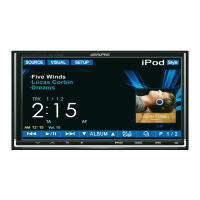
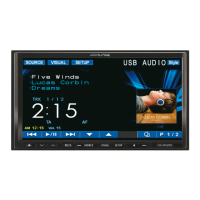
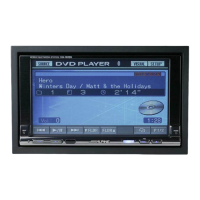
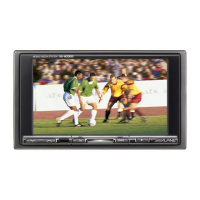


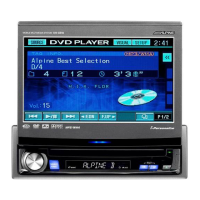
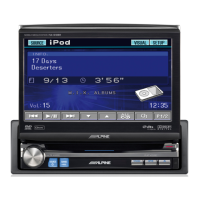



